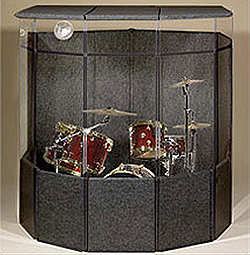
Electronic Drums
I’ve yet to meet a drummer who has said, “Awesome! Electronic drums—I can’t wait to play them!”
But even with the recent improvements in bounce back and feel, an electric kit still feels different than the real thing. I’ve also seen and experienced well-intentioned efforts that featured real cymbals and snare drum and electronic toms and kick, and it’s puzzling. Why would you leave the loudest elements of a drum kit to saturate the stage with sound?
Electronic drums do offer the advantages of being able to choose different sounds or “patches” for each piece of the kit and some drummers do like to pick different sounds for a specific song or for different styles of music.
Sometimes there’s no other good option than electronic drums, but in my book, let’s keep it real!
The Drum Cave
If your drummer won’t play on electronic drums and Hot Rod Sticks with a Plexiglas shield aren’t working, then I suppose, theoretically, it’s time to build a drum cave.
When my client mentioned “drum cave,” I realized that I’d already seen variations of it numerous times. Some of my favorites are what I call “The Glass House” or “All Plexiglas All The Time.”
When I see these things, I always feel sorry for the drummer and also hope that closed-ear headphones are employed. If not, the drummer will most likely be deaf in short order!
Another variation is the “sweat shop,” which usually consists of a well-insulated booth with a small opening in the top. The one major problem is that if it’s not equipped with a fan, the drummer will pass out during the second song.
I could go on with more variations, but I think you’re probably getting the picture.
What To Do?
A recent experience highlighted for me how sometimes experimenting and changing things can lead you to a better solution. A church I that I was working with had gone to electronic drums when they were holding services in a gym.
They had moved into a new 1,200-seat fan-shaped worship center and carried the electronic drums over to the new space while adding a real snare and cymbals.
With the cymbals and snare introducing more stage volume, they added a Plexiglas shield. Still having trouble, they asked me to come and work with them.
The first thing that I did was have them change to an all-acoustic kit and explained that adding a few extra drums would not add that much additional volume on the stage.
Immediately, I was the drummer’s hero. We found that with an acoustic kit the drummers played with considerably more finesse and dynamics. After a few weeks of the acoustic kit, I proposed that we remove the shield.
Every one of the sound team members told me it couldn’t possibly work and complained—and complained a lot! I argued that most musicians enjoy the live feel and sound on stage, and since the stage was almost 30 feet deep and 60 feet wide, the musicians could be spread out enough that the drums wouldn’t be too loud.
With considerable trepidation, they allowed me to remove the shield. What happened next surprised everyone (even me to some extent). The overall stage level actually decreased, and the band played tighter than they had before.
Reflecting as to why the stage volume went down requires some logic. When the drums were more isolated behind the shield, everyone was adding them into their personal monitor mix. So, rather than having one acoustic kit producing volume on the stage, it was like having five kits on stage.
The drummer also became more aware of the surroundings and played to match the volume of the other musicians on stage. The reason all of this worked was that with a large room and large stage, the drums did not overwhelm anyone.
There was (and always is) one exception. One very heavy handed drummer had to switch to Hot Rod Sticks when he realized that his cymbal work (more like cymbal walloping) was overwhelming the rest of the band (and annoying the front of house sound engineer). However, the shield remained off-stage.
Conclusion
I will close with this. I asked my client how the “drum cave” worked out. “With the big glass window in front, I now call it the fish bowl,” she said, a bit dejectedly. Let’s hope that drummer doesn’t drown in feeling isolated from everyone else,
The best way to go about this is work (hard if needed) with your musicians to come up with an amicable solution. I bet you’ll be as surprised as I was!
Gary Zandstra is a professional AV systems integrator with Parkway Electric and has been involved with sound at his church for more than 25 years.
